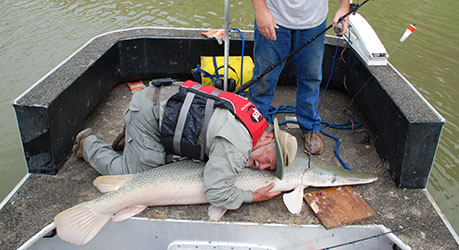Alligator Gar — Not A Threat to Humans

These big fish are not as fierce as they look.
The size and toothy appearance of alligator gar both excites anglers and frightens those that play in the waters they inhabit. Unfortunately, stories of alligator gar attacking people and dramatizations in popular television shows have given these gentle giants a bad rap. While there are no confirmed attacks on people, alligator gar continue to be feared by many.
The fact is these large fish can be quite sluggish and docile. For example, the feeding behavior of large adults makes them a challenge to catch. Alligator gar can be slow or hesitant to swallow a bait. If something is amiss or they feel resistance, the bait is often dropped. The teeth of the alligator gar are designed for holding and subduing prey, not tearing it into bite-sized chunks like sharks. Therefore, alligator gar don’t eat things they can’t swallow.
The only time alligator gar pose danger to people is when anglers try to land and handle these large, powerful fish. In addition to hosting a mouthful of sharp teeth, alligator gar are also covered with sharp, bony scales. If anglers are not careful, they can easily get cut or bruised. While landing, unhooking, and releasing a bass or crappie requires relatively little preparation, doing the same for an alligator gar takes a plan. Fish should be landed using a rope lasso, large net, or cradle. They should be kept on their stomach on the ground or boat deck in an area free and clear of debris or equipment. Anglers should use tools and wear cut-resistant gloves when removing hooks. Never stick your hands in the fish’s mouth and stay clear of the powerful tail. If released, the fish should be sent back head first. Finally, be careful! These fish leave behind a very slippery coating of slime that can cause slips and falls. Be prepared to clean your boat deck after landings, or land fish on the river bank.